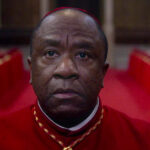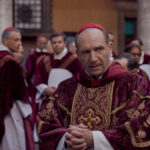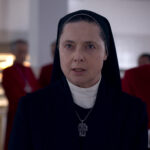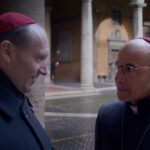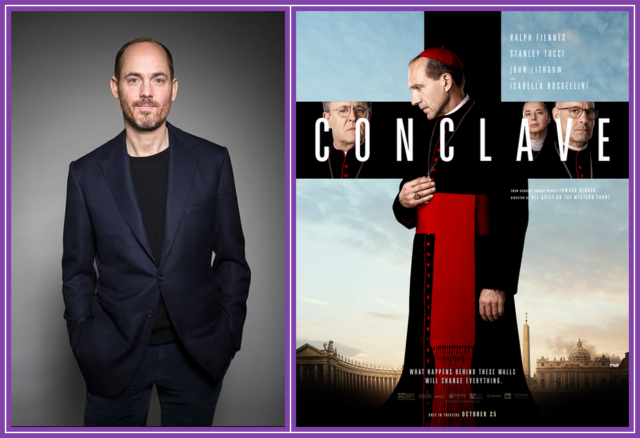
An insightful in-depth exclusive interview with director EDWARD BERGER discussing the masterful and fascinating CONCLAVE.
SYNOPSIS: CONCLAVE follows one of the world’s most secretive and ancient events – selecting the new Pope. Cardinal Lawrence (Ralph Fiennes) is tasked with running this covert process after the unexpected death of the beloved Pope. Once the Catholic Church’s most powerful leaders have gathered from around the world and are locked together in the Vatican halls, Lawrence uncovers a trail of deep secrets left in the dead Pope’s wake, secrets which could shake the foundations of the Church.
Directed by EDWARD BERGER with script by Peter Straughan based on the book by Robert Harris, CONCLAVE stars Ralph Fiennes, Stanley Tucci, John Lithgow, Lucian Msamati, Brían F. O’Byrne, Carlos Diehz, Merab Ninidze, Thomas Loibl with Sergio Castellitto and Isabella Rossellini.
The election of a pope is among the most closely guarded secrets in the world and thanks to not only author Robert Harris, but EDWARD BERGER and screenwriter Peter Straughan who adapted the novel, along with some impeccable research, we are taken behind the cloistered walls of the Sistine Chapel (built at legendary Cinecittà studios), into the papal process and into hearts and minds of cardinals from the world over as they vie for the position as leader of the Catholic Church. (If you haven’t read Harris’s book, I highly recommend it.)
CONCLAVE is a masterpiece. A conspiratorial political thriller with cardinals jockeying for power and papacy brought to the screen with the feel of an intimate chamber piece. Visually stunning. Painterly. Masterful storytelling that fascinates thanks to the deliberateness and calculated story structure which is brought to life visually and emotionally with metaphor and impeccable, award-worthy casting and performance. A perfect marriage of performance, cinematography and the film’s visual grammar, editing, and production values that is so seamless in its storytelling that on viewing, one may forget about the technical aspects of the film in favor of their own immersion and absorption into the story and their own emotional experience.
Highlighting the visual and thematic elements of CONCLAVE, during this exclusive interview Edward emphasizes the contrast between the hard, claustrophobic Casa Santa Marta where the Cardinals are staying and the open, airy spaces, symbolizing the cardinals’ confinement and humanity. Using natural, soft light, cinematographer Stephane Fontaine creates a somber yet engaging atmosphere while images are purposeful in their blocking and framing, and using ECUs to their best storytelling effect. Composer Volker Bertelmann delivers a score that adds a unique, non-traditional element, enhancing the film’s unconventional tone. Suzie Davies’ production design and the costume design of Lisy Christi add richness and symbolism, metaphorically speaking to the hard tenets of the Catholic Church and the visual nods to the blood of Christ with a color palette steeped in red, black, white, and gold. Expertly edited by Nick Emerson, the film’s deliberate pacing showcases the character development of each principal, led by Ralph Fiennes as Cardinal Lawrence, head of the conclave, drawing us into Lawrence’s contemplative and introspective journey.
Photos Courtesy of Focus Features. © 2024 All Rights Reserved.
As we dug deep into the making of CONCLAVE, with its visual richness and texture, filled with symbolism and metaphor, Edward and I broke down the masterful cinematic elements of the film with great detail, among them:
- the harmonious meld of production design and cinematography enhancing the film’s themes to visually convey ideas of power, hypocrisy, and the contrast between the institution and the individuals within it; the hard edges and lines, along with the marbling of the walls and floors reflect the tenets and rigid structure of the Catholic Church, creating a visual contrast with the flawed, mortal nature of the cardinals; the dark, claustrophobic Casa Santa Marta set design symbolize the confinement and sequestering of the cardinals, while the open, airy spaces represent freedom and release; natural, soft lighting that didn’t distract from the actors helps reinforce the film’s observational, contemplative tone and focus on the characters’ inner thoughts; camera angles from wide to mid-shots to ECUs and power dutching allow the audience to intimately connect with Cardinal Lawrence’s perspective and thought process as he uncovers the hidden secrets of his fellow cardinals.
- Stephane Fontaine’s cinematography; natural, soft light that comes through the low windows, creating a lot of dark shadows with the goal being to have natural, non-flashy lighting that doesn’t distract from the actors and the story; the use of front-lit lighting which can create a pure “magical” feel rather than relying on backlit techniques; deliberate observational camera work and framing; the benefit of six weeks of storyboarding and planning how to capture the architecture.
- finding the right locations which Edward believes is as crucial as casting the right actors
- Suzie Davies’s production design; the hard lines and marbling to reflect the tenets and rigid structure of the Catholic Church creates a visual metaphor for the flawed nature of the cardinals; contrast between the dark, claustrophobic Casa Santa Marta and the open, airy spaces symbolized the confinement and lack of freedom experienced by the cardinals during the conclave; enhanced metaphor with the cardinals’ rooms to foster the idea that these “holy men” are mere mortals and not on a pedestal; using production design to make the characters feel small and insignificant within the grand architecture of Rome, mirroring the film’s themes about the hypocrisy and flaws of the institution; the importance of production design in visually conveying the film’s themes of power, corruption, and the contrast between the ideals of the Church and the reality of the cardinals’ humanity.
- crafting the script and utilizing lensing and editing to convey Lawrence’s POV, wanting the script to feel like it was from Lawrence so it feels like we as the audience are in his head and can read his mind; using various camera angles and shots focused on Lawrence, such as going behind his head, above his eyeline, and using multiple close-ups; emphasizing the importance of every shot and edit being essential to further the story and convey something new, rather than relying on typical techniques like shot-reverse-shot.
- Volker Bertelmann’s exquisite score is intentionally designed to be a character in the film that speaks where the cardinals are silent, the score is meant to surprise and engage the audience, avoiding the expected emotional cues and instead creating a more independent dialogue between the image and sound that is more theatrical and immersive; the score should “wake up” the audience and tell them to “enjoy this, let’s have fun with it, let’s sit back and watch these people and have an experience, a theatrical experience.”
- Lisy Christi’s costume design; deliberately choosing rich, lush, thicker/heavier fabrics (even though they were more challenging for the actors due to the weight) to contrast with the muted architecture and create a visually striking contrast; the striking red color which adds another metaphoric layer to the visual richness of the film
- and more!
TAKE A LISTEN. . .
by debbie elias, exclusive interview 10/18/2024
CONCLAVE is in theatres October 25, 2024.



